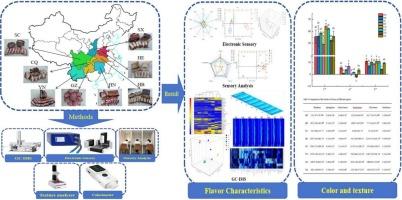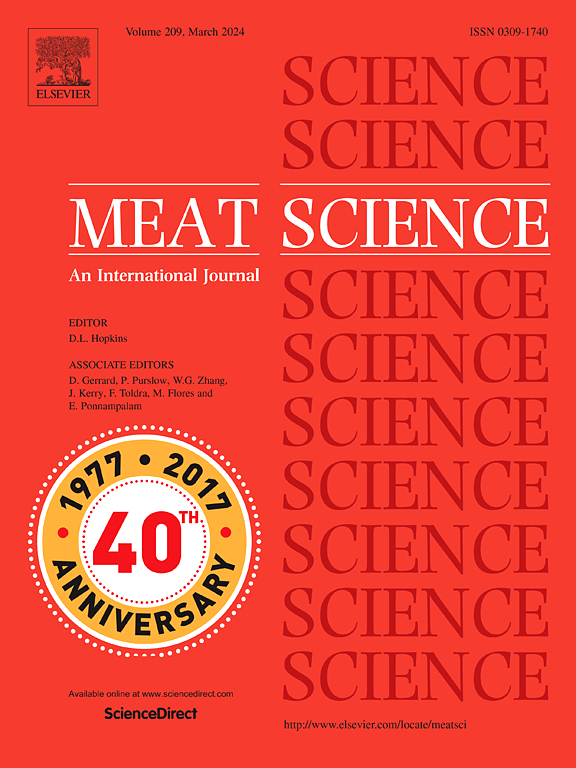利用气相色谱-质谱联用仪、电子感官评估和感官分析,研究不同地区腊肉的风味和品质特征。
IF 6.1
1区 农林科学
Q1 Agricultural and Biological Sciences
引用次数: 0
摘要
为了研究不同地区腊肉品质和风味的差异,我们采用了气相色谱-离子迁移谱法和电子感官技术(包括电子鼻和电子舌[e-nose 和 e-tongue]),对采购的腊肉样本进行风味分析。电子鼻和电子舌都成功地分辨出了不同腊肉品种的香气和味道。此外,有机硫化物、芳香苯和短链烷烃在不同类型的腊肉中含量更高。利用气相色谱-质谱(GC-IMS)技术,在不同的熏肉样本中鉴定出 52 种挥发性风味化合物,最终为每个样本建立了独特的指纹图谱。相对气味活性值确定 1-丙烯-3-甲硫基、2-庚酮、苯乙醛、糠基甲基硫醚和 1-辛烯是熏肉风味的主要成分。这些风味物质是造成不同地区熏肉风味差异的主要原因。挥发性风味化合物的相互作用导致使用电子鼻和电子舌检测到的气味特征之间存在显著差异,即使在挥发性风味成分相似的熏肉中也是如此。此外,腊肉的颜色和质地也有显著差异。湖北、云南和重庆的腊肉颜色较深。同时,HN(湖南)、HB(湖北)和 SC(四川)的腊肉硬度相对较低。这些结果不仅为腊肉风味的鉴别和控制提供了理论和技术上的启示,也为消费者在购买腊肉时做出明智的选择提供了依据。本文章由计算机程序翻译,如有差异,请以英文原文为准。

Investigating flavor and quality characteristics in Chinese bacon from different regions using integrated GC-IMS, electronic sensory assessment, and sensory analysis
To investigate the variance in the quality and flavor profiles of bacon from different regions, gas chromatography-ion mobility spectrometry and electronic sensory techniques (including electronic nose and tongue [e-nose and e-tongue, respectively]) were employed for the flavor analysis of the sourced bacon samples. Both the e-nose and e-tongue successfully distinguished the aromas and flavors of different bacon varieties. Additionally, organic sulfides, aromatic benzenes, and short-chain alkanes, were more abundant in different bacon types. Employing GC-IMS technology, identified 52 volatile flavor compounds within diverse bacon samples, culminating in the establishment of a distinct fingerprint for each individual sample. The relative odor activity value identified 1-propene-3-methylthio, 2-heptanone, phenylacetaldehyde, furfuryl methyl sulfide, and 1-octene as the primary contributors to bacon flavor. These flavor substances were the main cause of the differences in bacon flavor in different regions. The interaction of volatile flavor compounds resulted in notable disparities between the odor profiles detected using the e-nose and e-tongue, even among bacon with similar volatile flavor constituents. In addition, the color and texture of the bacon varied significantly. Bacon from HB (Hubei), YN (Yunnan), and CQ (Chongqing) showed darkness in color. Meanwhile, the hardness of bacon from HN (Hunan), HB (Hubei), and SC (Sichuan) was relatively low. These results not only provide theoretical and technical insights for bacon flavor identification and control but also offer a foundation for consumers to make informed choices when purchasing bacon.
求助全文
通过发布文献求助,成功后即可免费获取论文全文。
去求助
来源期刊

Meat Science
工程技术-食品科技
CiteScore
12.60
自引率
9.90%
发文量
282
审稿时长
60 days
期刊介绍:
The aim of Meat Science is to serve as a suitable platform for the dissemination of interdisciplinary and international knowledge on all factors influencing the properties of meat. While the journal primarily focuses on the flesh of mammals, contributions related to poultry will be considered if they enhance the overall understanding of the relationship between muscle nature and meat quality post mortem. Additionally, papers on large birds (e.g., emus, ostriches) as well as wild-captured mammals and crocodiles will be welcomed.
 求助内容:
求助内容: 应助结果提醒方式:
应助结果提醒方式:


